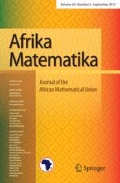Abstract
Words \({a_1a_2\ldots a_n}\) with independent letters a k taken from the set of natural numbers, and a weight (probability) attached via the geometric distribution pq i−1 (p + q = 1) are considered. The parameter \({{\mathcal K}(a_1a_2\ldots a_n)}\) , (the number of weak consecutive records), has proved to be essential in the analysis of a skip list structure. Related to it is the (new) parameter \({{\mathcal M}}\) , i.e., the largest consecutive record in a random word of length n. Exact and asymptotic formulæ are derived for the expectation and the variance.
Similar content being viewed by others
References
Andrews, G.: The Theory of Partitions. In: Encyclopedia of Mathematics and its Applications, vol. 2. Addison-Wesley, Reading (1976)
Archibald M., Knopfmacher A.: The average position of the dth maximum in a sample of geometric random variables. Stat. Probab. Lett. 79(7), 864–872 (2009)
Charalambides Ch.A.: Moments of a class of discrete q-distributions. J. Stat. Plan. Inference 135, 64–76 (2005)
Flajolet P., Sedgewick R.: Mellin transforms and asymptotics: Finite differences and Rice’s integrals. Theor. Comput. Sci. 144, 101–124 (1995)
Flajolet Ph.: Approximate counting: a detailed analysis. BIT 25(1), 113–134 (1985)
Graham, R.L., Knuth, D.E., Patashnik, O.: Concrete Mathematics, 2nd edn. Addison-Wesley, Reading (1994)
Kirschenhofer P., Prodinger H.: Approximate counting: an alternative approach. RAIRO Theor. Inf. Appl. 25, 43–48 (1991)
Kirschenhofer P., Prodinger H.: A result in order statistics related to probabilistic counting. Computing 51, 15–27 (1993)
Kortchemski, I.: Asymptotic behavior of permutation records. J. Combin. Theory Ser. A (6):1154–1166 (2009)
Louchard, G., Prodinger, H.: Analysis of a new skip list variant. Discrete Math. Theor. Comput. Sci. Proc. AG:365–374 (2006)
Louchard G., Prodinger H.: Generalized approximate counting revisited. Theor. Comput. Sci. 391, 109–125 (2008)
Prodinger H.: Hypothetic analyses: approximate counting in the style of Knuth, path length in the style of Flajolet. Theor. Comput. Sci. 100, 243–251 (1992)
Prodinger H.: Approximate counting via Euler transform. Math. Slovaka 44, 569–574 (1994)
Prodinger H.: Combinatorics of geometrically distributed random variables: left-to-right maxima. Discrete Math. 153, 253–270 (1996)
Prodinger H.: Records in geometrically distributed words: sum of positions. Appl. Anal. Discrete Math. 2, 234–240 (2008)
Szpankowski W., Rego V.: Yet another application of a binomial recurrence. Order statistics. Computing 43(4), 401–410 (1990)
Author information
Authors and Affiliations
Corresponding author
Rights and permissions
About this article
Cite this article
Oliver, K., Prodinger, H. Consecutive records in geometrically distributed words. Afr. Mat. 23, 163–172 (2012). https://doi.org/10.1007/s13370-011-0027-9
Received:
Accepted:
Published:
Issue Date:
DOI: https://doi.org/10.1007/s13370-011-0027-9




